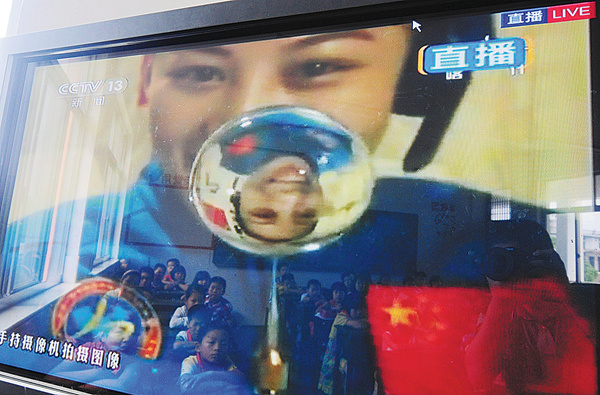

Ping-pong experiment
On Oct 16, "Teacher Wang", as called by many Chinese students who have watched the astronaut's lecture, embarked on her second space journey that would be much longer than the first. Inside the Shenzhou XIII spacecraft that was lifted by a Long March 2F rocket from the Jiuquan launch center, Wang and two male astronauts-Zhai Zhigang and Ye Guangfu-soon arrived in the core module of China's Tiangong space station orbiting Earth from about 400 km above.
In November, Wang, 41 at the time, became China's first female spacewalker as she took part in the Shenzhou XIII mission's first extravehicular activity.
In early December, the China Manned Space Agency announced that the Shenzhou XIII crew would hold a science lesson for students across the world from the Tiangong station. It would be the second open lecture delivered by Chinese astronauts and the first of the "Tiangong class", China's first extraterrestrial lecture series that aims to popularize space science.
The agency said such lectures will be based on the country's manned spaceflights and will be presented by Chinese astronauts. Featuring interactive teaching, the activities will be mainly targeted at youngsters.
It noted that as a Chinese space-based laboratory, besides its scientific tasks, Tiangong will also be tasked with promoting and propagating science and technology knowledge. The orbiting outpost has abundant, unique educational resources and boasts advantages when it comes to encouraging the public, especially young people, to embrace science and space exploration, it said.
On Dec 9, Wang and other crew members appeared on television screens watched by millions of students across China. They showed viewers how they live and work inside the space station, and displayed their exercise equipment and a specially designed spacesuit. During the lesson, Wang carried out experiments to display physical phenomena in microgravity such as disappearing buoyancy and a water ball.
Ye, who is on his first spaceflight, showed how to turn a body in the weightless environment.
During the hourlong activity, the astronauts also answered questions from students invited to "ground class venues" in Beijing, Nanning, capital of the Guangxi Zhuang autonomous region, Wenchuan in Sichuan province, and Hong Kong and Macao special administrative regions.
Vincent Wong Wai-shing, deputy principal of Hong Kong's Pui Kiu College, said after watching the lecture that the event gave Hong Kong students an opportunity to communicate with the astronauts and stimulate their interest in space and science.
"It also helped to enhance their sense of national identity as they saw the rapid development of our country's space technology," he said.
Yalie Wong, a student of Pui Kiu College, said, "What impressed me the most was the buoyancy experiment done with a ping-pong ball. It was amazing to see that the environment of space is very different from that of Earth."
Two space labs
On March 23, the Shenzhou XIII crew delivered their second science lecture, in which the astronauts also carried out experiments to show physical phenomena only possible in microgravity, including liquid crystallization and a water bridge.
In one experiment, Wang used a toy of Bing Dwen Dwen, the popular mascot of the 2022 Beijing Winter Olympics, to display how objects fly in a weightless environment. They also showed students two pieces of cutting-edge scientific equipment inside the space station.
Hundreds of students in Beijing, Lhasa, capital of the Tibet autonomous region, and Urumqi, capital of the Xinjiang Uygur autonomous region, watched the event at the "ground class venues".
Before ending the lecture, the astronauts answered questions taken from members of the public and raised by students at the ground venues. The questions covered various facets of life and work in space, such as how to take care of their skin, whether hot water is available, if the moon looks different from the Tiangong station, and how tears move in a microgravitational environment.
At the end of the class, Wang told the audience that in the coming months, two large space labs-Wentian, or "quest for the heavens", and Mengtian, or "dreaming of the heavens"-will be launched into space to dock with the Tianhe module to complete the Tiangong station, and then China will have stronger capability in terms of space-based scientific experimentation and the "Tiangong class" will become more interesting.
Pang Zhihao, a retired spaceflight researcher from the China Academy of Space Technology and author of several space-themed books, said the class will be an "eye-opener" for youngsters, especially students, by implanting the pursuit of science and innovation in them.
"Many distinguished scientists were created by their interest and curiosity about 'strange things'. The experiments done by the astronauts will put 'question marks' in our students' mind, and the youngsters will then move to find answers and explore more places unknown to humankind," he said.